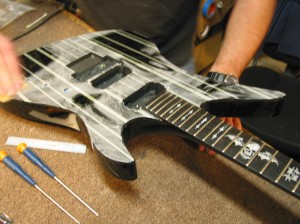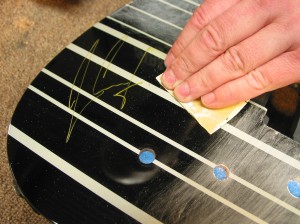Autographs on a guitar can disappear over time. Here’s how we make sure they don’t.

I’ve got a baseball behind my workbench signed by 1970’s Cubs outfielder Jose Cardinal (my favorite player as a kid.) I don’t play ball with it because I know that autograph would disappear quickly. Baseballs are cheap, so I play ball with another one.
This Schecter Synyster Custom was played onstage and autographed by the members of Avenged Sevenfold. The owner wanted to keep those autographs safe so he had two options: hang it on the wall and never play it OR have us finish over the top of the signatures to keep them protected. He wanted to play it, so we opted to spray a few clear coats of polyurethane over the top.

For the new paint to bond properly to the original finish, we need to scuff the surface with sandpaper – taking great care not to sand away the signatures. Before we can do that, we have to remove the pickups, bridge, and controls.


Next it heads into the spray booth for several coats of clear poly, followed by wet-sanding and buffing it to a high gloss Finally, we put it all back together with the Works setup.

These signatures look exactly the way they did when the guitar arrived. But the owner won’t have to worry about playing it now that they’re sealed. Every guitar that has meaningful autographs should have this work done.

Would this work for an acoustic violin and acoustic guitar?
It definitely would for an acoustic guitar – and should for a violin as well. We don’t work on violins at all, so I’d suggest checking with a shop that does finish work on those for that particular project.
I have a black electric guitar that Keith Urban personally played and autographed at a concert last week. He gave it to me later that night and I was ecstatic. I believe he signed it with a gold sharpie. I got home and realized the sharpie was starting to wear off. I am so upset and just don’t know what to do! I thought about using a clear lacquer or something, but I am afraid I would somehow ruin it, therefor I would like it to be professionally done. Would this be the way to go? Please let me know ASAP
Savannah,
I just sent you a more detailed response in a direct email. Don’t apply any clear lacquer over it on your own. You definitely want to have this professionally done. Happy to help out any time.
How much would it cost to have you do what you did on the Schecter described on your page?. I have a Paul Stanley signature Ibanez signed by about 14 different people.
DJ, I’ll email you an estimate shortly. One thing I’ll mention (and it may be worthy of another blog post) is that it’s necessary to scuff the surface of the existing guitar so the new clear paint adheres properly to the original finish. While it simplifies things to scuff the surface before having it signed, it is possible to work between the signature lines. It just means using tiny fingertip abrasives to get into all the small areas between Sharpie lines. This takes more time obviously but it can be done.
Hello
So i have a few guitars that id like done but the first one that comes to mind in an acoustic maton. My question is this; how friendly is the procedure to paint pens?
Aaron, First off, sorry for my slow response. I’m always quicker through regular email. The procedure is friendly to paint pens. As you can see, the tricky thing is sanding around the signature, but the finish will adhere with a paint pen as well as a permanent marker like a Sharpie. Our recommendation is to have the surface scuffed and prepped before having the guitar autographed (if possible.)
Hi Steve,
If I was to have this done to my guitar would it potentially decrease the value due to the original finish being altered?
That really depends on the guitar, the potential buyer, and on your plans for that guitar. If it’s a vintage, collectable, or otherwise valuable guitar that you intend to sell, then you probably shouldn’t have it autographed in the first place. Let’s say you had Les Paul himself sign your 50’s Les Paul – the value has already decreased to most potential buyers once that autograph happens. If it’s a fairly recent production guitar like a Mexican-made Strat, then it’s a perfect candidate because its value doesn’t appreciate over time like a 60’s Strat would and a little more clear polyurethane won’t hurt its value.